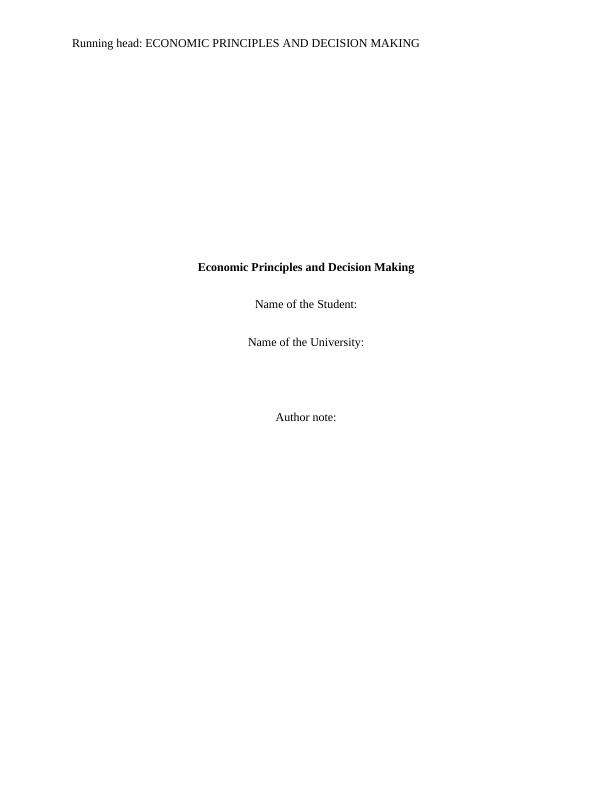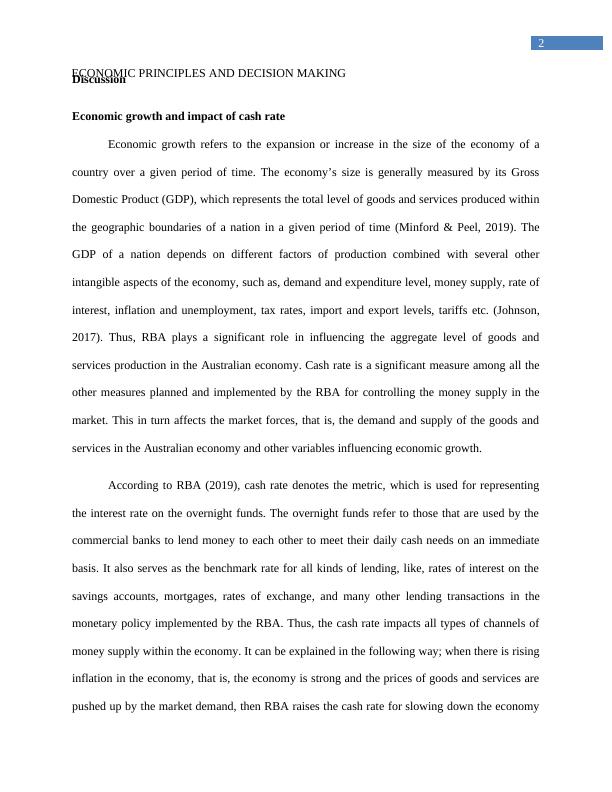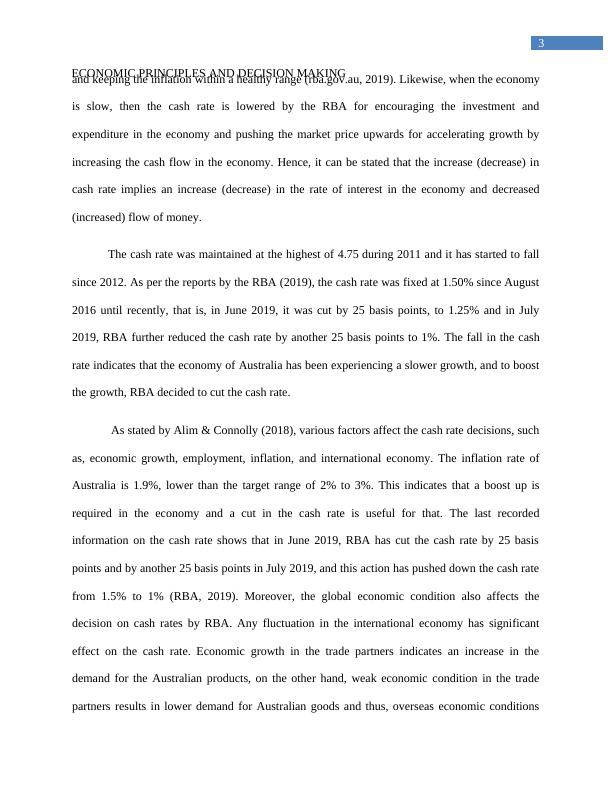Economic principles and decision making
Added on 2022-09-18
15 Pages4552 Words24 Views
Running head: ECONOMIC PRINCIPLES AND DECISION MAKING
Economic Principles and Decision Making
Name of the Student:
Name of the University:
Author note:
Economic Principles and Decision Making
Name of the Student:
Name of the University:
Author note:

1
ECONOMIC PRINCIPLES AND DECISION MAKINGIntroduction
The Australian economy has achieved a world record for achieving the longest running
period of growth since July 1991. The global economic growth rate has been fluctuating over the
past few years but Australia has succeeded in maintaining a positive growth rate even during the
global financial crisis (GFC). In spite of experiencing a fall in the biggest economic sector,
mining, the country was able to tone down the negative blow on the economy. Bell (2017)
highlighted that the monetary policies introduced by the Reserve Bank of Australia (RBA) had a
significant contribution in helping the economy to rise above the challenges emerged from the
global financial crisis in 2007-2008. The GDP of Australia was AU $1.69 trillion in 2017, and its
total wealth as of 2016 was AU $8.9 trillion (Greasley et al. 2017). The rate of inflation has been
almost stable over the time period and it was 1.9% in the first quarter of 2019, implying a
reasonable economic growth. The unemployment rate is around 5% in 2018-19 in spite of job
creation (Davidson & Dorsch, 2018). Cash rate influences the money market significantly. It is a
significant element of monetary policies planned by the RBA. Cash rate refers to the overnight
money market interest rate. Change in the cash rate has knock-on effects investment, spending,
inflation and unemployment in the economy (Hijzen et al., 2018). The cash rate is assumed to
decline more from 1.5% and the GDP might also decline from 3% in 2019. These would indicate
a slower growth for the economy of Australia. Furthermore, the biggest trading partner of
Australia is China, and it is also experiencing a slowdown in the economy, which would also
impact the growth rate of the Australian economy. This report will discuss the above mentioned
aspects of the Australian economy along with the external aspects, such as, the economic
slowdown of China and its effect on the Australian economy in order to explore and examine the
growth possibility of the country.
ECONOMIC PRINCIPLES AND DECISION MAKINGIntroduction
The Australian economy has achieved a world record for achieving the longest running
period of growth since July 1991. The global economic growth rate has been fluctuating over the
past few years but Australia has succeeded in maintaining a positive growth rate even during the
global financial crisis (GFC). In spite of experiencing a fall in the biggest economic sector,
mining, the country was able to tone down the negative blow on the economy. Bell (2017)
highlighted that the monetary policies introduced by the Reserve Bank of Australia (RBA) had a
significant contribution in helping the economy to rise above the challenges emerged from the
global financial crisis in 2007-2008. The GDP of Australia was AU $1.69 trillion in 2017, and its
total wealth as of 2016 was AU $8.9 trillion (Greasley et al. 2017). The rate of inflation has been
almost stable over the time period and it was 1.9% in the first quarter of 2019, implying a
reasonable economic growth. The unemployment rate is around 5% in 2018-19 in spite of job
creation (Davidson & Dorsch, 2018). Cash rate influences the money market significantly. It is a
significant element of monetary policies planned by the RBA. Cash rate refers to the overnight
money market interest rate. Change in the cash rate has knock-on effects investment, spending,
inflation and unemployment in the economy (Hijzen et al., 2018). The cash rate is assumed to
decline more from 1.5% and the GDP might also decline from 3% in 2019. These would indicate
a slower growth for the economy of Australia. Furthermore, the biggest trading partner of
Australia is China, and it is also experiencing a slowdown in the economy, which would also
impact the growth rate of the Australian economy. This report will discuss the above mentioned
aspects of the Australian economy along with the external aspects, such as, the economic
slowdown of China and its effect on the Australian economy in order to explore and examine the
growth possibility of the country.

2
ECONOMIC PRINCIPLES AND DECISION MAKINGDiscussion
Economic growth and impact of cash rate
Economic growth refers to the expansion or increase in the size of the economy of a
country over a given period of time. The economy’s size is generally measured by its Gross
Domestic Product (GDP), which represents the total level of goods and services produced within
the geographic boundaries of a nation in a given period of time (Minford & Peel, 2019). The
GDP of a nation depends on different factors of production combined with several other
intangible aspects of the economy, such as, demand and expenditure level, money supply, rate of
interest, inflation and unemployment, tax rates, import and export levels, tariffs etc. (Johnson,
2017). Thus, RBA plays a significant role in influencing the aggregate level of goods and
services production in the Australian economy. Cash rate is a significant measure among all the
other measures planned and implemented by the RBA for controlling the money supply in the
market. This in turn affects the market forces, that is, the demand and supply of the goods and
services in the Australian economy and other variables influencing economic growth.
According to RBA (2019), cash rate denotes the metric, which is used for representing
the interest rate on the overnight funds. The overnight funds refer to those that are used by the
commercial banks to lend money to each other to meet their daily cash needs on an immediate
basis. It also serves as the benchmark rate for all kinds of lending, like, rates of interest on the
savings accounts, mortgages, rates of exchange, and many other lending transactions in the
monetary policy implemented by the RBA. Thus, the cash rate impacts all types of channels of
money supply within the economy. It can be explained in the following way; when there is rising
inflation in the economy, that is, the economy is strong and the prices of goods and services are
pushed up by the market demand, then RBA raises the cash rate for slowing down the economy
ECONOMIC PRINCIPLES AND DECISION MAKINGDiscussion
Economic growth and impact of cash rate
Economic growth refers to the expansion or increase in the size of the economy of a
country over a given period of time. The economy’s size is generally measured by its Gross
Domestic Product (GDP), which represents the total level of goods and services produced within
the geographic boundaries of a nation in a given period of time (Minford & Peel, 2019). The
GDP of a nation depends on different factors of production combined with several other
intangible aspects of the economy, such as, demand and expenditure level, money supply, rate of
interest, inflation and unemployment, tax rates, import and export levels, tariffs etc. (Johnson,
2017). Thus, RBA plays a significant role in influencing the aggregate level of goods and
services production in the Australian economy. Cash rate is a significant measure among all the
other measures planned and implemented by the RBA for controlling the money supply in the
market. This in turn affects the market forces, that is, the demand and supply of the goods and
services in the Australian economy and other variables influencing economic growth.
According to RBA (2019), cash rate denotes the metric, which is used for representing
the interest rate on the overnight funds. The overnight funds refer to those that are used by the
commercial banks to lend money to each other to meet their daily cash needs on an immediate
basis. It also serves as the benchmark rate for all kinds of lending, like, rates of interest on the
savings accounts, mortgages, rates of exchange, and many other lending transactions in the
monetary policy implemented by the RBA. Thus, the cash rate impacts all types of channels of
money supply within the economy. It can be explained in the following way; when there is rising
inflation in the economy, that is, the economy is strong and the prices of goods and services are
pushed up by the market demand, then RBA raises the cash rate for slowing down the economy

3
ECONOMIC PRINCIPLES AND DECISION MAKINGand keeping the inflation within a healthy range (rba.gov.au, 2019). Likewise, when the economy
is slow, then the cash rate is lowered by the RBA for encouraging the investment and
expenditure in the economy and pushing the market price upwards for accelerating growth by
increasing the cash flow in the economy. Hence, it can be stated that the increase (decrease) in
cash rate implies an increase (decrease) in the rate of interest in the economy and decreased
(increased) flow of money.
The cash rate was maintained at the highest of 4.75 during 2011 and it has started to fall
since 2012. As per the reports by the RBA (2019), the cash rate was fixed at 1.50% since August
2016 until recently, that is, in June 2019, it was cut by 25 basis points, to 1.25% and in July
2019, RBA further reduced the cash rate by another 25 basis points to 1%. The fall in the cash
rate indicates that the economy of Australia has been experiencing a slower growth, and to boost
the growth, RBA decided to cut the cash rate.
As stated by Alim & Connolly (2018), various factors affect the cash rate decisions, such
as, economic growth, employment, inflation, and international economy. The inflation rate of
Australia is 1.9%, lower than the target range of 2% to 3%. This indicates that a boost up is
required in the economy and a cut in the cash rate is useful for that. The last recorded
information on the cash rate shows that in June 2019, RBA has cut the cash rate by 25 basis
points and by another 25 basis points in July 2019, and this action has pushed down the cash rate
from 1.5% to 1% (RBA, 2019). Moreover, the global economic condition also affects the
decision on cash rates by RBA. Any fluctuation in the international economy has significant
effect on the cash rate. Economic growth in the trade partners indicates an increase in the
demand for the Australian products, on the other hand, weak economic condition in the trade
partners results in lower demand for Australian goods and thus, overseas economic conditions
ECONOMIC PRINCIPLES AND DECISION MAKINGand keeping the inflation within a healthy range (rba.gov.au, 2019). Likewise, when the economy
is slow, then the cash rate is lowered by the RBA for encouraging the investment and
expenditure in the economy and pushing the market price upwards for accelerating growth by
increasing the cash flow in the economy. Hence, it can be stated that the increase (decrease) in
cash rate implies an increase (decrease) in the rate of interest in the economy and decreased
(increased) flow of money.
The cash rate was maintained at the highest of 4.75 during 2011 and it has started to fall
since 2012. As per the reports by the RBA (2019), the cash rate was fixed at 1.50% since August
2016 until recently, that is, in June 2019, it was cut by 25 basis points, to 1.25% and in July
2019, RBA further reduced the cash rate by another 25 basis points to 1%. The fall in the cash
rate indicates that the economy of Australia has been experiencing a slower growth, and to boost
the growth, RBA decided to cut the cash rate.
As stated by Alim & Connolly (2018), various factors affect the cash rate decisions, such
as, economic growth, employment, inflation, and international economy. The inflation rate of
Australia is 1.9%, lower than the target range of 2% to 3%. This indicates that a boost up is
required in the economy and a cut in the cash rate is useful for that. The last recorded
information on the cash rate shows that in June 2019, RBA has cut the cash rate by 25 basis
points and by another 25 basis points in July 2019, and this action has pushed down the cash rate
from 1.5% to 1% (RBA, 2019). Moreover, the global economic condition also affects the
decision on cash rates by RBA. Any fluctuation in the international economy has significant
effect on the cash rate. Economic growth in the trade partners indicates an increase in the
demand for the Australian products, on the other hand, weak economic condition in the trade
partners results in lower demand for Australian goods and thus, overseas economic conditions

End of preview
Want to access all the pages? Upload your documents or become a member.
Related Documents
Economic Principles and Decision Makinglg...
|15
|4425
|71
Principles of Economics: Monetary Policy, Money Market, and Economic Relations of Australialg...
|22
|4249
|251
Economic Principles and Decision Making.lg...
|5
|286
|99
Case Study on Australia's Economic Conditionlg...
|19
|4464
|39
Australia Economic Progress Reportlg...
|6
|907
|420
Factors behind decline in economic growthlg...
|17
|4384
|1
